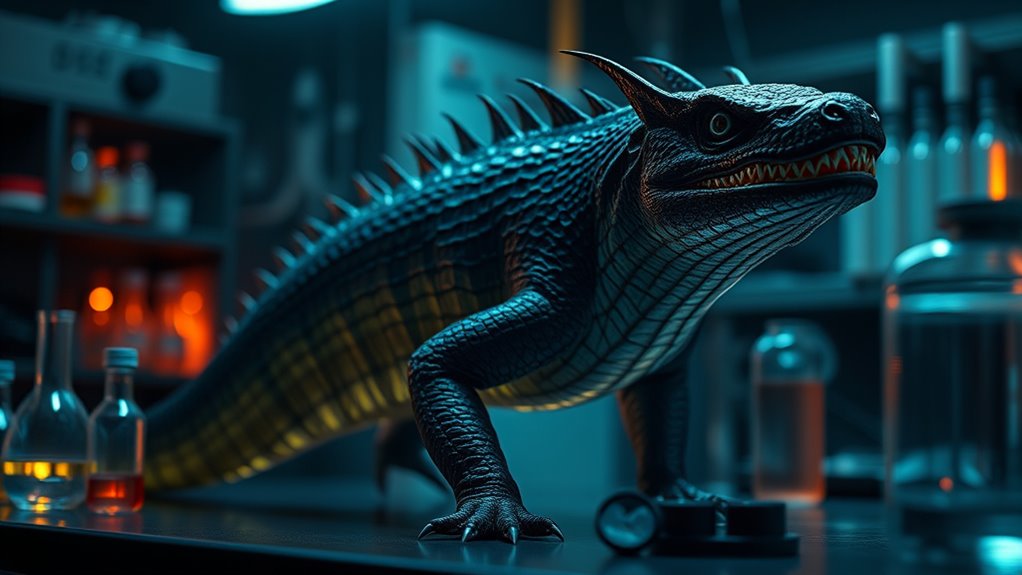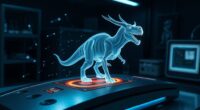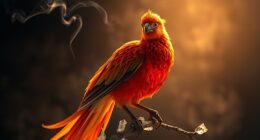Bio-printed chupacabras are currently more science fiction than imminent reality, but advances in bio-printing and genetic engineering make their creation increasingly possible. While researchers can now create complex biological tissues and structures, replicating a mythical creature with its unique traits remains a major challenge due to ethical concerns, technical limitations, and environmental risks. As science blurs the line between myth and reality, exploring these possibilities could reveal surprising breakthroughs—if you want to learn more, keep exploring this fascinating frontier.
Key Takeaways
- Current bio-printing technology can create complex tissues but cannot yet produce mythical creatures like chupacabras.
- Ethical and ecological risks hinder the development of bio-printed mythical beings.
- Advances in genetic engineering and synthetic biology are approaching capabilities that could enable such creations.
- The idea remains largely in science fiction, with significant scientific and ethical barriers to realization.
- Ongoing research may eventually blur the line between myth and reality, but bio-printed chupacabras are not imminent.
The Origins and Legend of the Chupacabra

The legend of the chupacabra began in Puerto Rico in the mid-1990s, when residents reported mysterious attacks on livestock that left behind drained carcasses. This event sparked curiosity and fear, fueling the legend’s origins in local folklore. As stories spread, the chupacabra became a prominent figure in cryptid folklore, symbolizing the unknown and the eerie. People described it as a creature with sharp teeth, spines along its back, and a reputation for blood-sucking. While some believe it’s a supernatural entity, others think it’s a misidentified animal or a hoax. Regardless of the truth, the legend’s origins are rooted in these early accounts, cementing the chupacabra’s place in the cultural fabric of Latin America and beyond.
The Science Behind Bio-Printing and Genetic Engineering
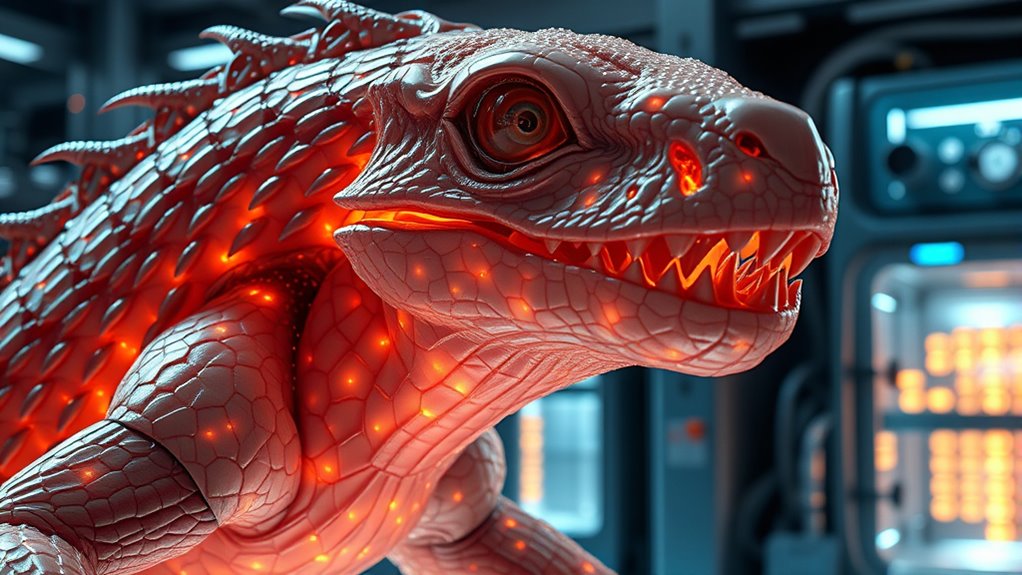
You can understand bio-printing by looking at how 3D cell layering creates complex tissues. Gene editing techniques, like CRISPR, allow precise modifications to DNA, shaping an organism’s traits. However, these advancements raise important ethical questions about creating and manipulating life forms.
3D Cell Layering
D cell layering forms the foundation of bio-printing by organizing living cells into precise, functional structures. This process mimics natural tissue formation, creating complex biological systems. By carefully controlling cell layering, you can build tissues that grow and function like their natural counterparts.
Here are four key points to consider:
- Cell layering ensures cells are positioned correctly for optimal interaction.
- Tissue scaffolding provides support, guiding cell growth during layering.
- Precise layering enhances the stability and longevity of printed tissues.
- It allows customization for specific biological functions and structures.
Mastering cell layering is vital for developing bio-printed organs or creatures, like the mythical chupacabra, by replicating the intricate architecture of living tissues.
Gene Editing Techniques
Gene editing techniques are the backbone of advanced bio-printing, allowing scientists to modify genetic material with pinpoint accuracy. CRISPR applications stand out, enabling precise edits to DNA sequences, which is vital for creating tailored biological tissues. With CRISPR, you can target specific genes to enhance desirable traits or remove harmful mutations. Additionally, gene drive technology offers the ability to spread genetic modifications through populations quickly, potentially controlling or eliminating pests or diseases. These tools give you unprecedented control over genetic design, making it possible to engineer organisms with specific features. As bio-printing advances, harnessing these gene editing techniques becomes essential for producing complex, functional biological structures—like bio-printed chupacabras—that blend genetics with cutting-edge manufacturing.
Ethical Considerations
As bio-printing and genetic engineering advance, ethical considerations become increasingly critical to address. You must contemplate the moral dilemmas surrounding creating or altering creatures like chupacabras. These technologies raise questions about animal rights, such as whether it’s ethical to manipulate living organisms for research or entertainment. Here are key points to consider:
- Animal Welfare: Are bio-printed creatures subjected to unnecessary suffering?
- Playing God: Should humans have the power to design entirely new species?
- Environmental Risks: Could released bio-printed animals disrupt ecosystems?
- Societal Impact: How might these creations influence our moral boundaries and laws?
Balancing scientific progress with ethical responsibility is essential to avoid crossing moral lines that could have lasting consequences.
Current Advances in 3D Bioprinting Technologies

Recent advances in 3D bioprinting technologies have revolutionized the way researchers create complex biological structures. You can now engineer tissues that mimic natural ecosystems, enabling the development of synthetic ecosystems with enhanced functionality. These innovations allow for precise placement of cells and biomaterials, supporting biological augmentation where tissues are optimized for specific purposes. Techniques such as multi-material printing and rapid prototyping have accelerated progress, making it possible to produce more lifelike and functional biological constructs. This progress not only advances medical applications like organ regeneration but also opens new avenues for creating bioengineered creatures. As the technology evolves, you’ll find that the boundaries between science fiction and reality continue to blur, bringing us closer to designing complex living systems in the lab.
Possibilities of Creating Mythical Creatures in the Lab
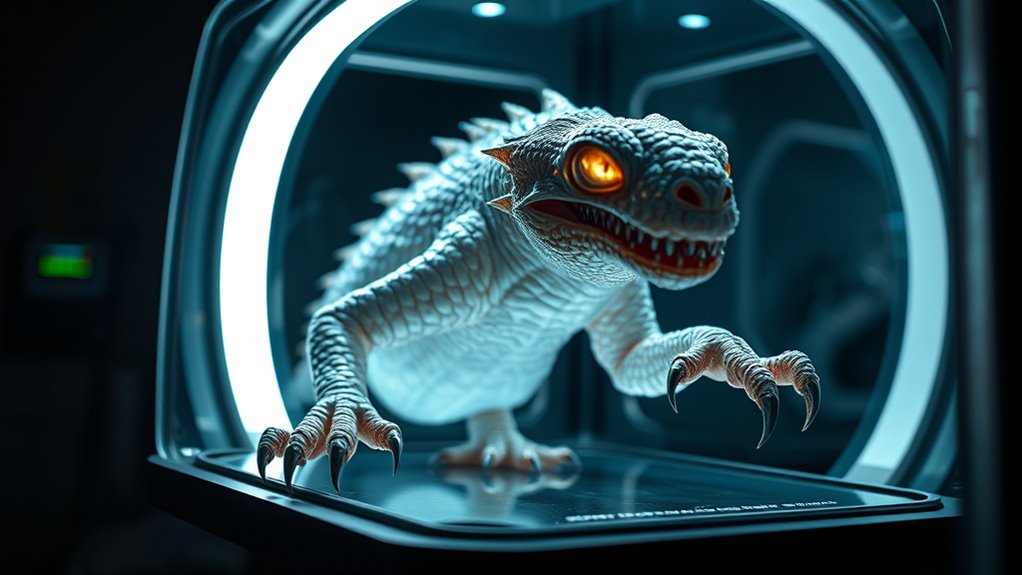
Creating mythical creatures in the lab raises questions about genetic engineering limits and whether we can truly control complex traits. Ethical concerns grow as we consider the implications of bringing fantastical beings to life. Yet, the potential to customize traits opens new doors for innovation and imagination.
Genetic Engineering Limitations
While genetic engineering has made remarkable advances, transforming lab techniques into mythical creatures remains highly limited. You face significant genetic limitations and bioengineering constraints that hinder this goal.
Consider these key challenges:
- Incomplete understanding of complex traits prevents precise control over mythical features.
- Gene editing precision isn’t perfect, risking unintended mutations.
- Inter-species genetic compatibility issues make combining traits difficult.
- Limited knowledge of developmental processes restricts predicting how genes influence complex features.
These factors mean you can’t simply “edit” genes to create a mythical creature. The genetic limitations and bioengineering constraints keep such ambitions within the domain of science fiction—for now.
Ethical Concerns Rise
As scientists grapple with the technical hurdles of engineering mythical creatures, ethical concerns quickly come to the forefront. Biotech ethics come into play as you consider the morality of creating beings that blur the line between nature and invention. You might question whether it’s right to bring creatures like chupacabras into existence, especially when their sentience and welfare aren’t fully understood. Creature morality becomes a major issue—do these beings deserve rights or protection? The potential for suffering, unintended consequences, or disrupting ecosystems raises serious moral questions. As you navigate these issues, you realize that pushing the boundaries of bio-printing demands careful reflection on the responsibilities involved. Ethical concerns aren’t just abstract debates; they shape whether such mythical creatures should even be created.
Potential for Custom Traits
The potential for customizing traits in bio-printed mythical creatures opens exciting possibilities for innovation and experimentation. With advances in genetic customization and trait modulation, you could design creatures with specific features. Imagine:
- Adjusting size, from tiny to enormous, to suit different environments.
- Modifying skin texture or color for camouflage or aesthetic effects.
- Enhancing sensory abilities like night vision or heightened smell.
- Introducing unique traits, such as wings or horns, that don’t exist in nature.
This capability pushes boundaries, allowing you to craft beings with tailored characteristics. While this opens doors for scientific breakthroughs, it also raises questions about morality and unintended consequences. The line between science fiction and reality continues to blur as these possibilities become more tangible.
Ethical Considerations and Potential Risks
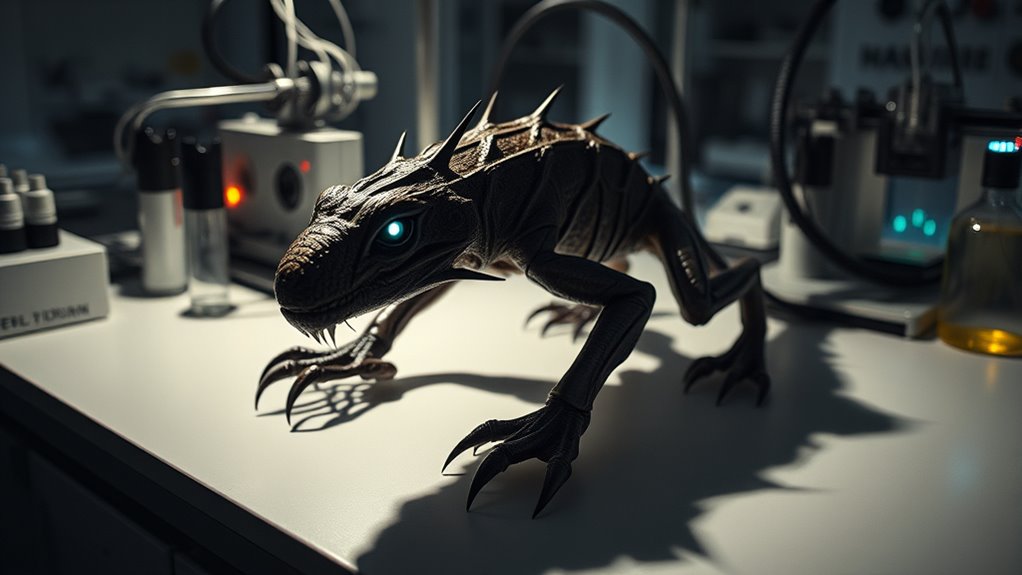
Ethical considerations and potential risks surrounding bio-printed chupacabras demand careful scrutiny, especially as this technology pushes the boundaries of science and morality. You must consider animal rights, as creating such creatures raises questions about their welfare and the morality of manufacturing life for novelty or profit. Ecological risks are also significant; introducing bio-printed chupacabras into natural environments could disrupt existing ecosystems, threaten native species, or cause unpredictable consequences. Additionally, there’s the concern of misuse or accidental release, which could lead to unforeseen ecological damage. As you explore this emerging technology, it’s crucial to balance scientific curiosity with responsible stewardship, ensuring that ethical standards are upheld and risks minimized before moving toward practical applications.
Scientific Challenges in Bio-Printing Complex Organisms
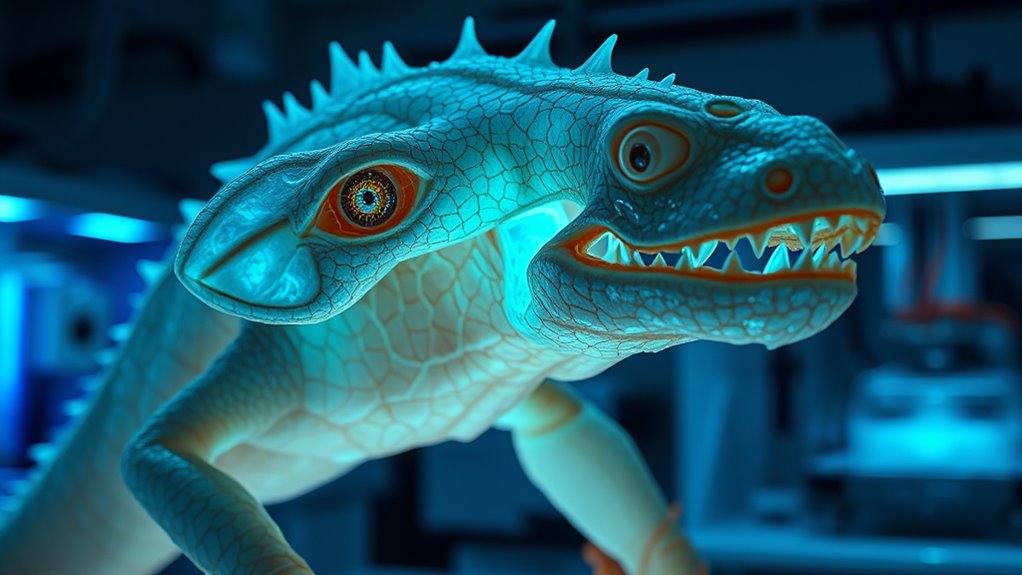
Bio-printing complex organisms like chupacabras presents a host of scientific hurdles that go beyond ethical debates. First, creating effective tissue scaffolding is essential to support cell growth and organization. Without robust scaffolds, tissues lack structure and functionality. Second, vascular integration remains a major challenge; you need to develop viable blood vessel networks to ensure nutrient delivery and waste removal. Third, replicating the organism’s intricate anatomy requires precise layering and spatial control, pushing current bio-printing limits. Finally, maintaining cell viability throughout the process is critical, especially when dealing with diverse cell types and complex tissues. Overcoming these hurdles demands breakthroughs in biomaterials, bioreactor technologies, and precise printing techniques—key steps toward turning bio-printing from science fiction into reality.
The Role of Synthetic Biology in Future Innovations

Synthetic biology stands at the forefront of transforming future innovations by enabling precise manipulation of genetic and cellular functions. You can now engineer organisms with tailored traits, opening doors to breakthroughs like lab-grown organs or bio-printed creatures. However, these advances raise significant questions about genetic ethics, especially when creating organisms with human-like features or complex behaviors. Synthetic art emerges as a new frontier, blending biology and creativity to produce living sculptures or bio-designs. As you explore these possibilities, remember that responsible innovation relies on balancing scientific progress with ethical considerations. Synthetic biology’s potential extends beyond medicine and art—it could redefine the very boundaries of life and what it means to create. Your role is pivotal in shaping a future where innovation and ethics coexist.
Public Perception and Cultural Impact of Bio-Printed Creatures
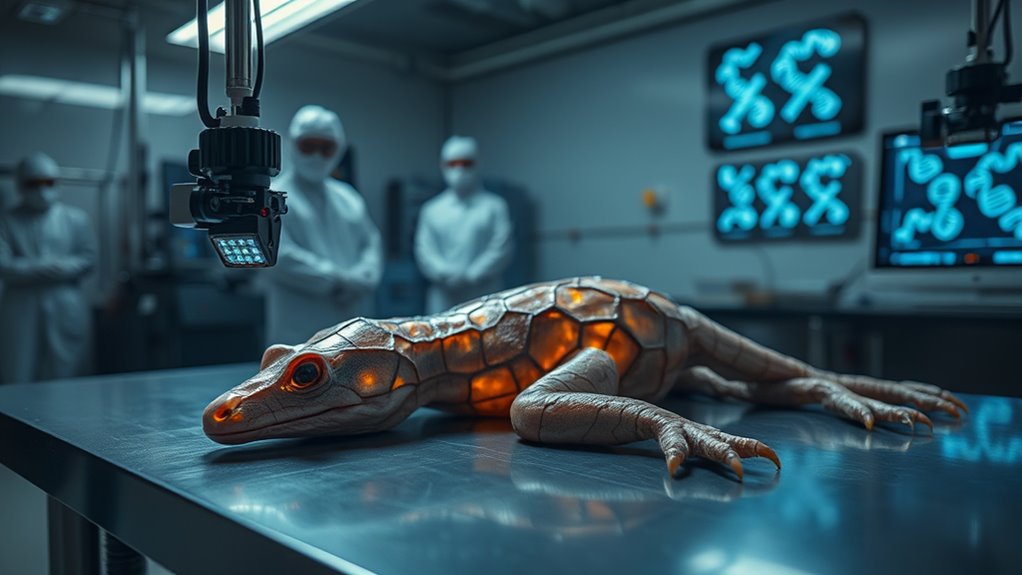
Have you ever wondered how society reacts to the idea of bio-printed creatures like chupacabras? Public skepticism runs high, fueled by fears of unintended consequences and ethical dilemmas. Cultural symbolism plays a significant role, as chupacabras often represent fears of the unknown and threats to tradition. Here are four ways public perception shapes this debate:
- Fear of Unnatural Creation – Many see bio-printed creatures as crossing ethical boundaries.
- Media Influence – Sensational stories amplify skepticism and misunderstanding.
- Cultural Symbolism – Chupacabras evoke deep-rooted fears and folklore, complicating acceptance.
- Potential for Misuse – Concerns about bio-printing technology being weaponized or misused persist.
Understanding these perceptions is vital for steering the cultural impact of bio-printed creatures in society.
Future Perspectives: From Fictional Creatures to Scientific Breakthroughs

Although the idea of creating creatures like chupacabras once belonged solely to folklore and science fiction, advances in bio-printing are now turning these fantasies into near-future realities. This shift fuels mythic creativity, blurring the lines between imagination and scientific possibility. As researchers explore the limits of bio-printing, ethical debates intensify about the implications of bringing mythical creatures to life. You must consider the moral responsibilities involved in manipulating living tissues to craft beings once confined to legends. Future breakthroughs could lead to extraordinary scientific achievements, but they also challenge societal norms and ethical boundaries. Balancing innovation with responsibility becomes pivotal as we shift from fictional concepts to tangible, bio-printed realities that could revolutionize medicine, conservation, and our understanding of life itself.
Frequently Asked Questions
Could Bio-Printed Chupacabras Survive Outside Laboratory Conditions?
You wonder if bio-printed chupacabras could survive outside lab conditions. While advances might make it possible, ethical considerations and technological limitations pose challenges. You need to contemplate whether it’s responsible to create such organisms and if current tech can sustain them in natural environments. Until these issues are addressed, it’s unlikely that bio-printed chupacabras will thrive outside controlled settings.
How Long Would It Take to Bio-Print a Complete Creature?
You might wonder how long it takes to bio-print a complete creature. It depends on technological challenges like developing precise bioprinters and suitable bio-inks, which can take months or years. Ethical considerations also influence the timeline, as researchers must guarantee safety and morality. While progress is rapid, creating a fully functioning organism remains complex, and it could still take significant time before bio-printing a complete creature becomes feasible.
Are There Legal Regulations Governing the Creation of Bio-Printed Mythical Animals?
You might wonder if legal regulations cover bio-printed mythical animals. Currently, ethical considerations and intellectual property laws are still catching up with this emerging technology. While some countries have guidelines for genetic modification, specific laws for creating mythical creatures are limited or nonexistent. You should stay informed about evolving regulations, as they’ll shape responsible practices and protect both creators and the broader public from potential risks.
What Are the Potential Ecological Impacts of Releasing Bio-Printed Creatures?
You should consider that releasing bio-printed creatures could disrupt ecological balance. These new animals might become invasive species, outcompeting native species for resources and leading to unforeseen environmental consequences. Such releases could threaten biodiversity and destabilize ecosystems. It’s essential to carefully evaluate potential impacts before introducing bio-printed creatures into the wild, as their ecological effects could be profound and difficult to reverse.
Can Bio-Printing Replicate the Behaviors and Instincts of Real Animals?
You wonder if bio-printing can replicate animal behaviors and instincts. While genetic mimicry can imitate physical traits, replicating complex instincts is more challenging. You’d need to program neural pathways or use advanced AI to mimic instinctual responses. Though some progress exists, true behavior replication remains difficult. So, you might see some superficial mimicry, but fully capturing animal instincts with bio-printing isn’t quite within reach yet.
Conclusion
As you consider the leap from myth to molecule, remember that the line between science fiction and reality blurs with each breakthrough. Will bio-printed chupacabras become our next scientific marvel or monstrous myth? The choice lies in our hands, shaping a future where imagination fuels innovation. As the horizon of bioengineering expands, you hold the power to decide whether these creatures are mere legends or groundbreaking realities waiting to be born.

